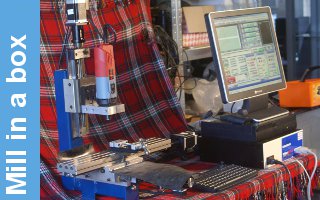HRP Plastow Boiler
There will be various ways of economising during the building and there are few modellers who will do this with any detriment to the finished article. One point to consider for saving is the boiler; will it be copper or steel? There can be no possible doubt that a copper boiler is best, since it has extremely long life, commands a high price for the model when selling and makes for very free steaming. Although the cost of copper may appear comparatively high, it is not when compared to the value of the finished model and the difference in price obtained when selling. However, some builders with economy in mind may well wish to build a steel boiler. Often in the case of an older builder this makes extremely good sense; he may only wish to make the model for his own enjoyment, and a steel boiler will last as long as he personally required it to.
If one has finally decided to make a steel boiler for their model, then good sense dictates that the thickness of the boiler plates and shell in steel should be greater than in copper, thus ensuring that there is ample wastage allowance before reaching scale thickness of the boiler plates. It is not easy to obtain steel plates in the smaller fractional sizes, therefore this wifl generally mean adding on 1 / 16th" to the stated thickness on one's drawing, if steel is to be used instead of copper. Although this must mean some detriment in that the boiler will not steam quite so freely, properly designed model boilers generally seem to be over-steamers, and therefore one feels that this loss of efficiency will not be appreciable in the finished model. Of course, the decision to build steel boilers should I feel, never be taken on very small models, since one cannot scale wastage or other forms of corrosion loss. This decreasing of metal thickness will occur on a small model at least at the same rate as it does on an original engine. It will be readily appreciated that if one were to add on an extra II 16th" thickness on the plates of a very tiny model boiler it might be quite impractical, since it would probably not steam at all well and would decrease the water spaces to an alarming extent, therefore reducing the capacity of the boiler.
Having scale models in mind, the reader will realise that whereas II 16th" or slightly more of wastage on a full scale engine after 20 years might well bring a frown to the owner's brow, the same amount would have scrapped a model long before. One might well ask "Why worry-20 years is a long time?" but there can be no doubt that apart from the physical fact that wastage cannot be any slower in a model, it is extremely likely that it will be a great deal faster, for the reason that in proportion, a small model boiler will use a very much greater than scale volume of steam. Just to mention a few reasons, there will be more starting and stopping of the engine; much more wet steam will be used; and over-scale loads will be hauled with the engine using a fierce fire and consuming a proportionately greater volume of water, carrying more dissolved oxygen into the boiler, thus accelerating wastage. Of course, wastage can be minimised, and this was achieved in the full sized engines in various ways. It was always considered better to leave an engine full of water than empty, since the water in the boiler would carry less oxygen (dissolved oxygen) than the atmosphere, and therefore less wastage would occur; better still was for the boiler to be full of water which had already been used for steaming, which contained a much lower percentage of active oxygen. A modern day equivalent of this is in the steel central heating radiator which has long life due to the heating unit using the same water continuously. A further practice was to open the blower when first lighting the engine, thus allowing oxygen-bearing air to escape, and its place being taken by steam, the least injurious of the two. To sum up, conditions which would appear to be best for boiler life, e.g.: a completely dry boiler, are far from ideal, and those which appear to be harmful, e.g.: full of water, are more suitable. Always remember, it is the oxygen in the air and the relatively small proportion of dissolved oxygen in water which promotes the wastage or rusting. Therefore it is best to fill your steel boiler full of water, when not in use, shutting down all cocks to exclude air.
When one takes a look at the very large models, it will be fairly obvious that there is not really a decision to be taken as to what the boiler shall be made of. It is appreciated that copper boilers can be made and are made, but the price of extremely large boilers in copper is exhorbitant, and although these can probably be effectively welded up by the Argon-Arc process there are not many companies who will undertake it. In any event this process would be extremely costly. Against this, when one is dealing with a very large model boiler made in steel, the additional wastage allowance can be added to the thickness of the plate without any appreciable detriment to steaming, yet ensuring a very long life of the boiler if properly used.
From the point of view of safety in both copper and steel boilers, it cannot be emphasized too strongly that these should be brazed or welded by a competent person. This does not for one moment exclude the model engineer, who is often a more meticulously careful engineer than the professional. However, with the copper boilers, deep penetration of the brazing material is necessary and proper fusion of the rod and boiler plates is definitely required in steel boilers. Therefore one should be satisfied that one is capable of carrying out this work, and if doubtful, seek advice from a Model Engineer Club, or instruction through technical college evening classes.
Boilers in general are not as difficult to make as they sometimes appear to be, but at the same time one must not treat them too lightly; a good standard of workmanship is required not only for safety, but also if one wishes to obtain boiler insurance for the model. Most rally organisers today insist on boiler insurance for the protection of the public, and quite rightly so. To obtain insurance the boiler will need to be passed by a Board of Trade boiler inspector, thus neat and tidy welding with correct fusion in a steel boiler is required. With copper boilers, all seams should have a nice neat radius of brazing material, the same applying to all stays, and there should be neat and tidy workmanship throughout, these points giving ample indication of penetration and satisfying the boiler inspector's visual check. If the boiler has been properly made, there will be little doubt that it will pass the inspector's hydraulic test. It is usual on a model for the inspector to pump up or press the boiler to twice the working pressure, and he may wish to hold this pressure for up to an hour, during which time he will measure for any undue expansion or distortion across the firebox and compare this with caliper measurements taken before the pressure was applied. There is always some expansion, and the inspector satisfies himself that this is within reasonable limits. With a model boiler generally carrying an excess of stays and normally being designed very much over-strong, there should be little fear of a boiler failing the test if reasonable workmanship has been used throughout.










